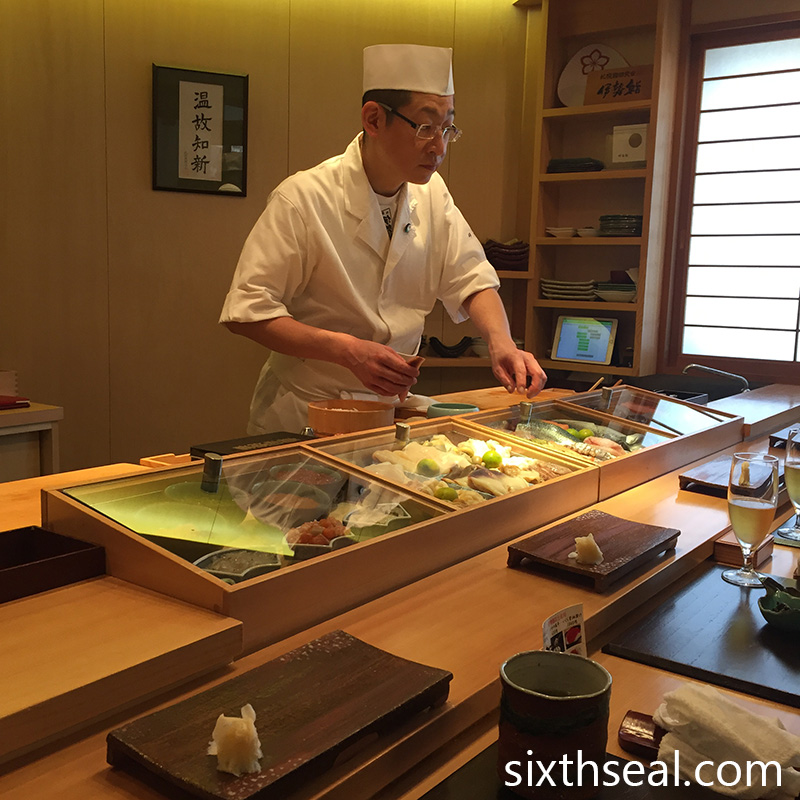
This is one of the highlights of our trip. Isezushi is the only One Michelin Star sushiya (sushi bar) in Otaru and I wanted to eat there as soon as we made plans to go to Hokkaido. I made reservations weeks in advance. You have to call them as they don’t accept Internet reservations. It took two calls of about 20 minutes to get the message though but I managed to get us counter seats!
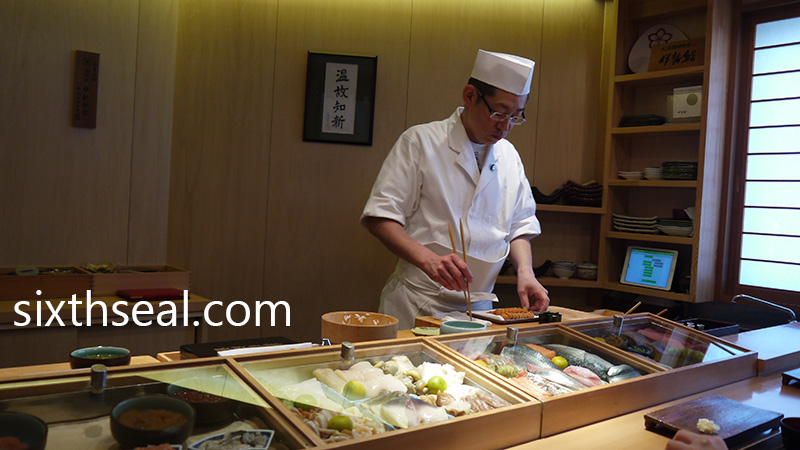
It’s always important to get a counter/bar seat if you’re going for the omakase. The experience is diluted if you’re seated at a table as you can’t watch and interact with the sushi chef. You want a counter seat as the tempo is dictated by the sushi chef, putting pieces of sushi on your personal board one-by-one, as it is made, instead of all at once if you’re seated at the tables.

This is how sushi is meant to be eaten and I’m glad I took the time (and long distance call charges) to communicate that I wanted a counter seat at all costs.
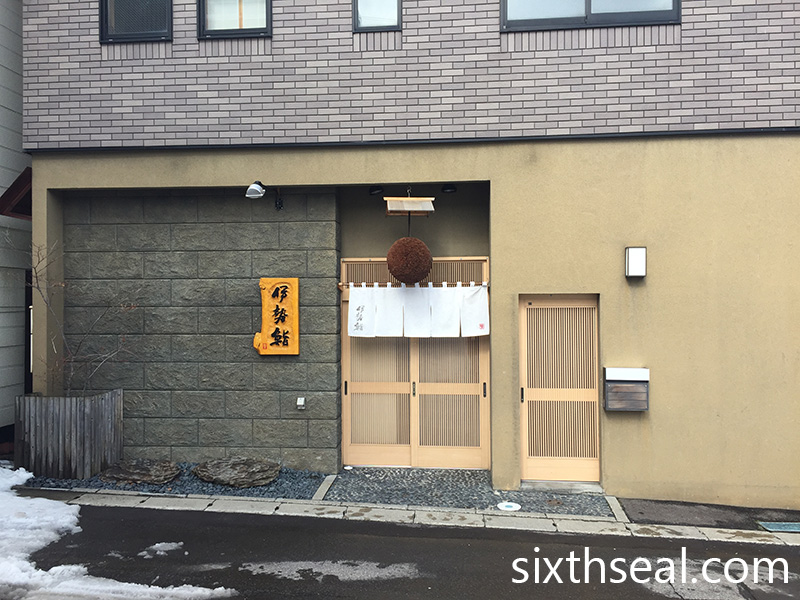
Isezushi is located about 6 minutes away from JR Otaru Station. The restaurant is very minimalistic on the outside. You won’t be able to know what they’re serving if you don’t read Japanese and there are no signboards in English. The doors are perpetually closed with no waiter outside. This is a strict reservation-only place and it’s very prim and proper.
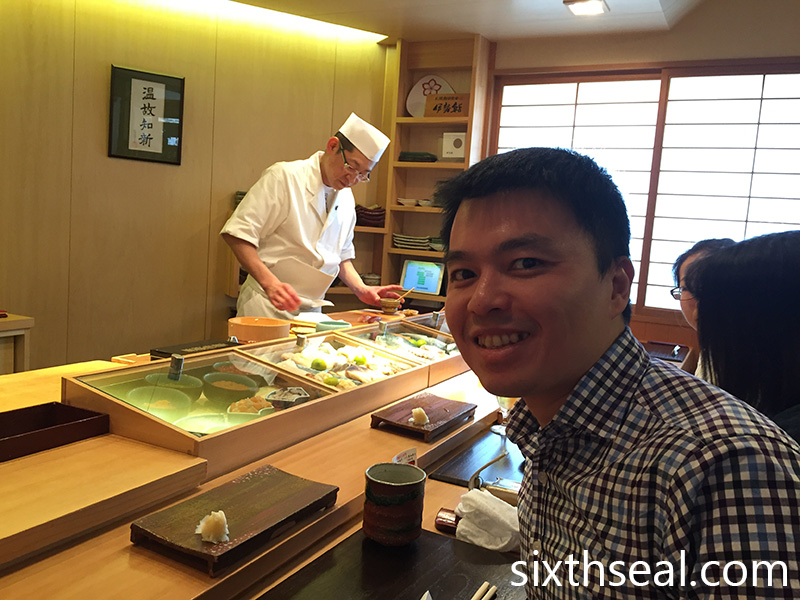
Our reservation was at 12:30 pm but I made sure we arrived nice and early at 11:50 am as I know they are very particular about punctuality. Sure enough, the sushi chef was pleasantly surprised we were there early and seated us promptly. There were two other Japanese women beside us on the counter and a lone Japanese male taking up the last seat. The two tables behind the counter were full too!
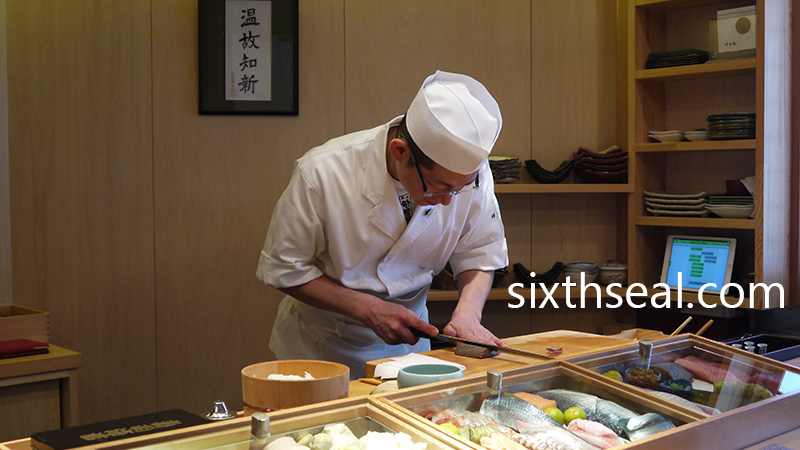
There are three different omazake tiers – this is the classic Sho/Chiku/Bai trio of price levels in Japanese dining. The most premium one is called Jun (JPY 6,300) and has 16 pieces of sushi. The middle tier is Dai (JPY 3,600) and it’s made up of 12 pieces of sushi made exclusively from Hokkaido ingredients. The budget set is Gin (JPY 3,000) and has 10 pieces of sushi. I went for the Jun and my better half opted for the Dai omakaze.
Isezushi Jun Omakase (16 pieces for JPY 6,300)
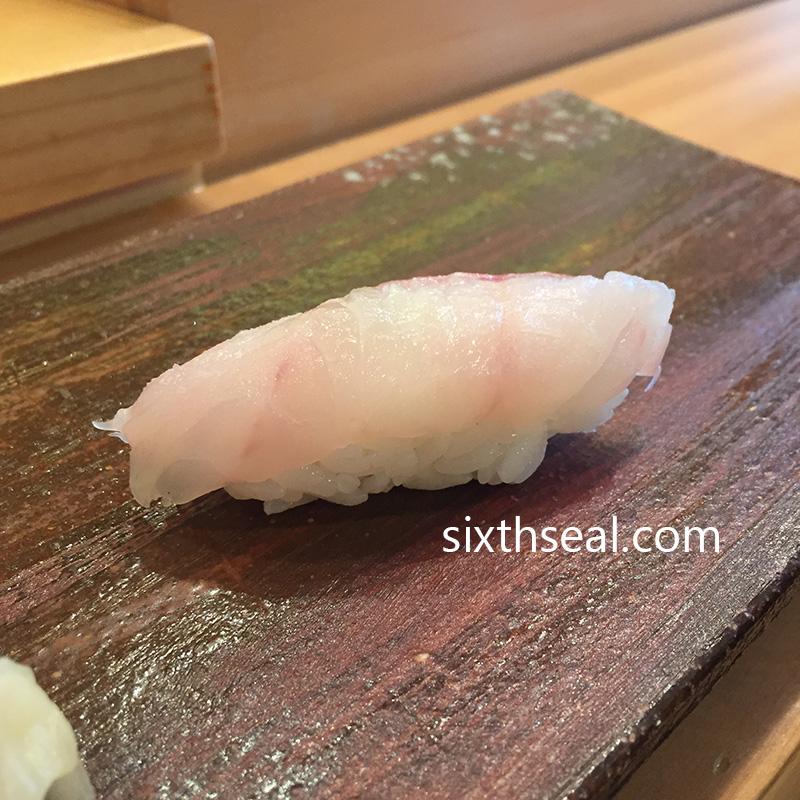
Soi (Rockfish/大とろ)
This is a nice start to the meal. I love how the sushi chef masterfully seasoned everything with just enough citrus/soy/wasabi/salt so you’re not supposed to use any more yourself. I’ve also never seen citrus being used to season rockfish before and it was tender and flavorful, with a sharp and refreshing bite.
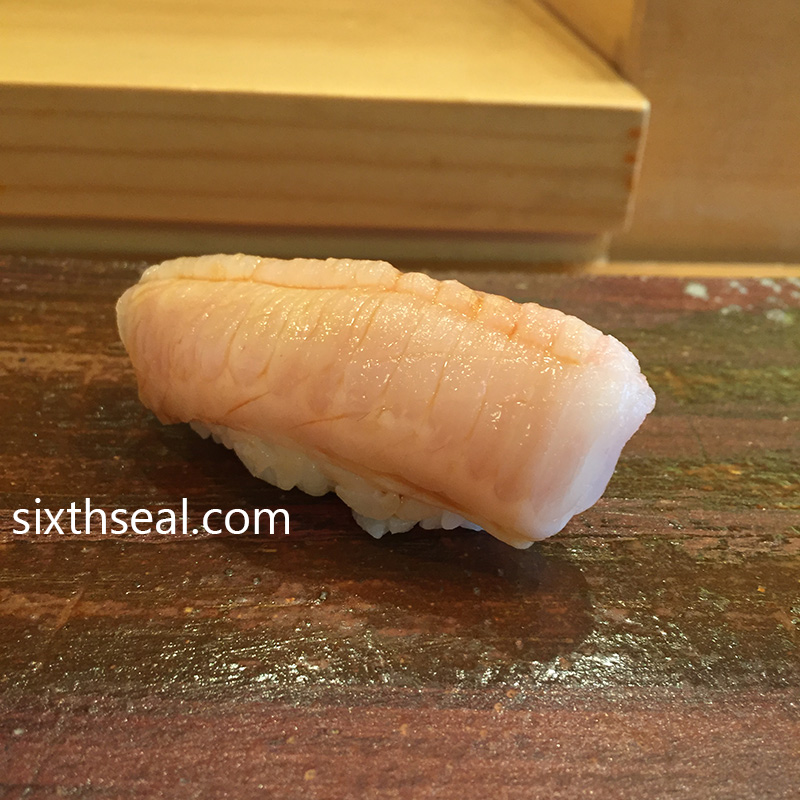
Engawa (Edge of flounder/さば漬け)
This is a very rare piece of sushi which you can only get from the high end Jun omakaze. You can’t get it from the a la carte menu. It’s described as “flounder’s edge” and the sushi chef showed me the piece of fish where it came from. It’s a crunchy and chewy neta.

Akamizuke (Tuna belly marinated in shoyu/本鮪の漬)
This is a piece from the tuna’s belly called “zuke”. It’s marinated in soy sauce for a while and served on top of sushi. This is the best tasting and highest quality akamizuke I’ve ever had! I’ve eaten a lot of “akamizuke” which are just pieces of cheap tuna in soy sauce and it tastes completely different from the real thing.
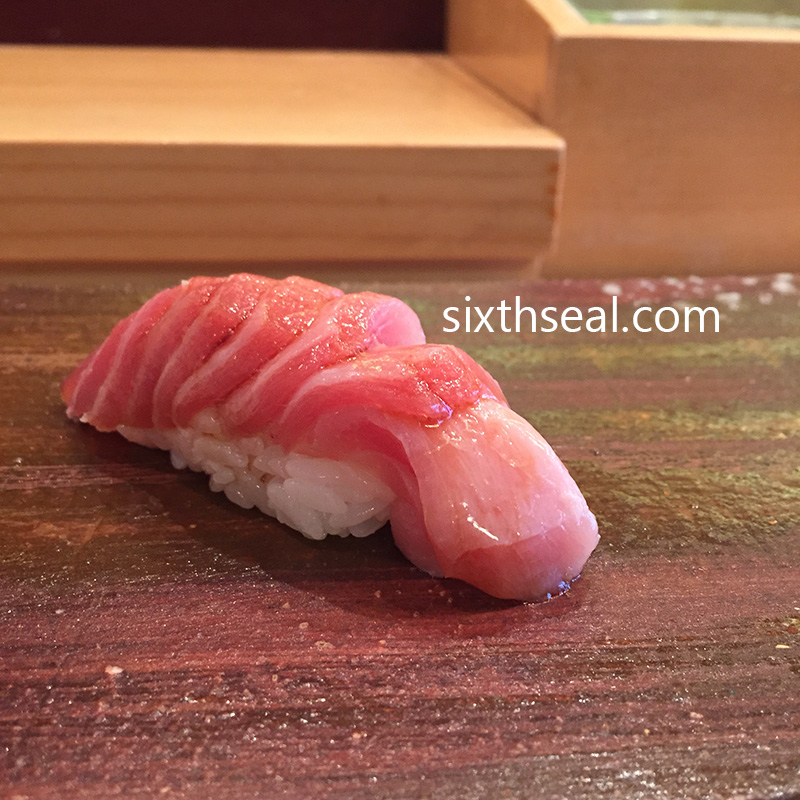
Otoro (Fatty tuna belly/大とろ)
This requires no further explanation. It’s the most expensive and most premium piece of sushi. There’s only a relatively tiny amount of meat on a bluefin tuna that can be properly classified as otoro and they usually sell for USD 30 or more per piece. The otoro was deliciously fatty, with a rich and lingering buttery mouthfeel. I’m very happy to have had experienced this.

Sabazuke (Mackerel marinated in shoyu/鯖)
Yum! This perfectly complements the otoro that I had just eaten. Just to be sure, I cleansed my palate with pieces of pickled ginger before starting on each piece of sushi. The mackerel is sliced very well, the difference between a high end sushi bar and a conveyer belt sushi is nowhere more apparent than here – the cuts are precise and there are multiple ones done on the surface of the fish so it produces an explosion of flavor when it touches your tongue.
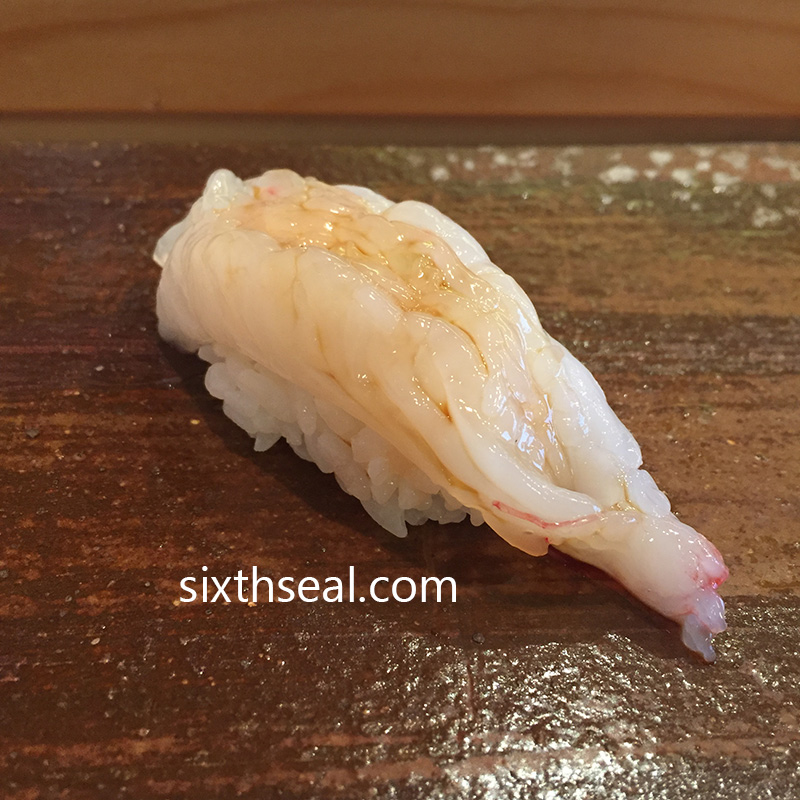
Botan-ebi (Sweet jumbo Japanese shrimp/ぼたんえび)
This is the large sweet shrimp that’s only available in Japan. They’re also called Toyama Shrimp and they’re found in Hokkaido. It’s a highly seasonal item that’s only available from November to March so I’m lucky to catch the tail end of the season (no pun intended). It’s my favorite piece of sushi – I love raw shrimp.
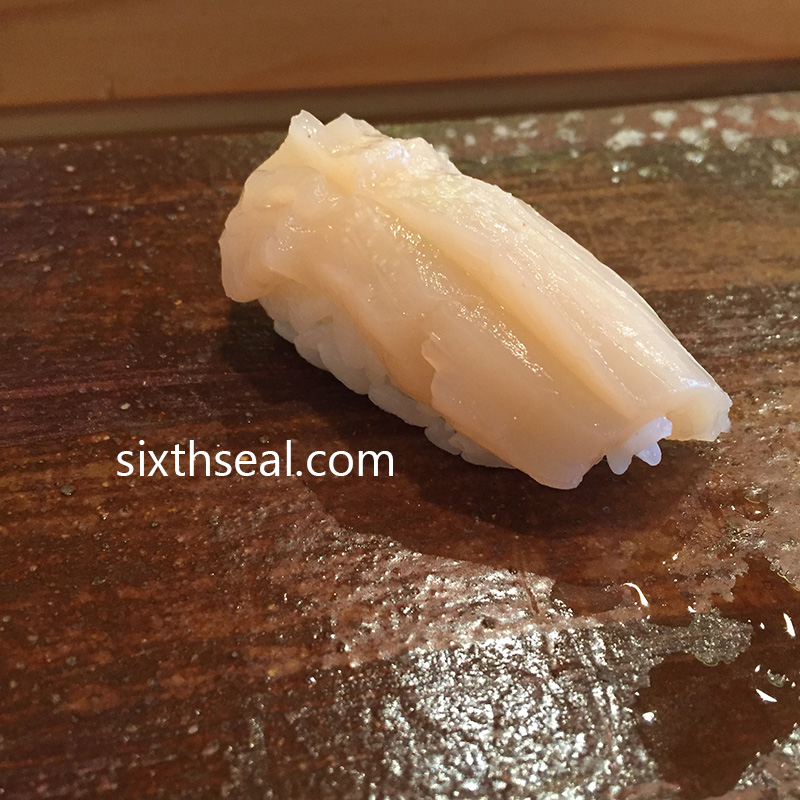
Hotate (Scallops/帆立貝)
Hokkaido has a HUGE local scallop industry and I’ve eaten a lot of scallops in many forms (sashimi, dried, and even in ramen) while I was here. They’re possibly one of the sweetest sushi toppings around. It’s delicious and I closed my eyes in pleasure while eating it. No joke.

Hokkigai (Surf clam/ホッキ貝)
Crunchy! It’s very fresh too since the surf clam is sourced right from Otaru on the very day itself. I liked the contrasting texture between the soft scallops to the crispy surf clam.
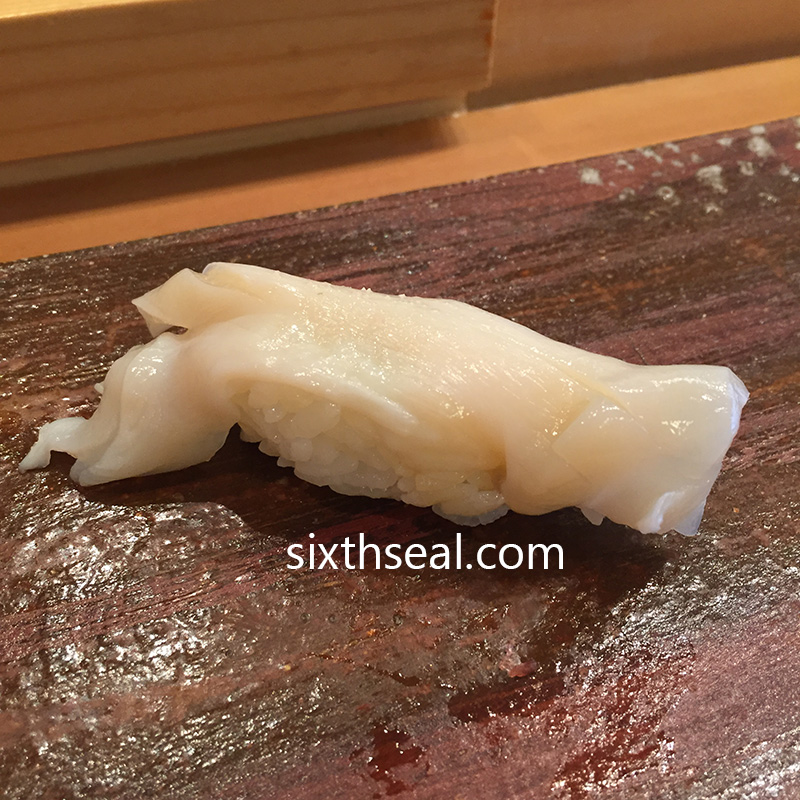
Tsubugai (Whelk/ツブガイ)
I like whelk and I love how the sushi chef carefully sliced this from the shell, pounded it a few times with his knife and made small and shallow cuts diagonally to tenderize and let the flavors out.
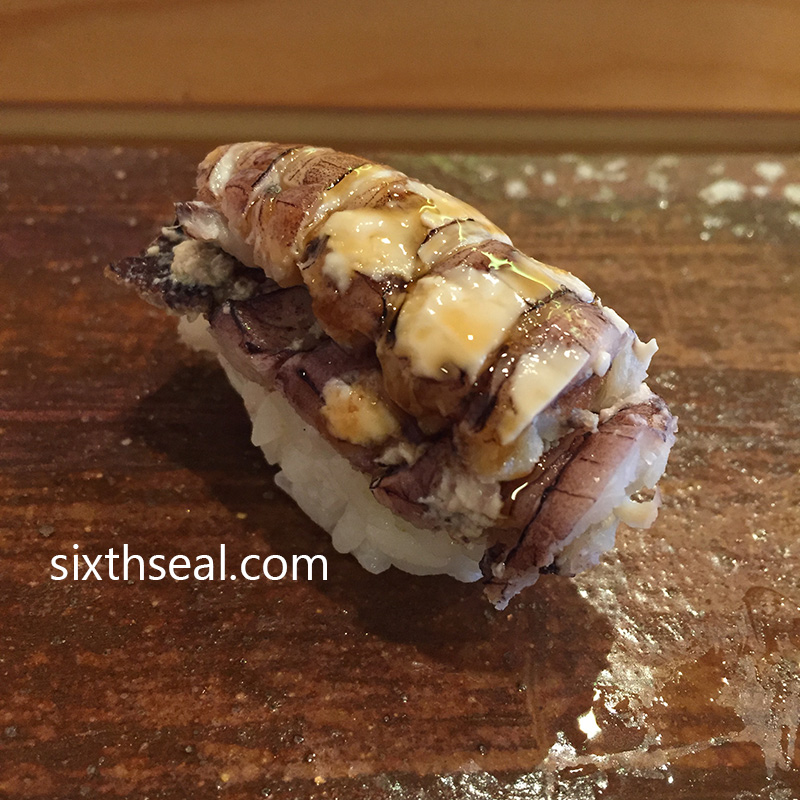
Shako (Squilla mantis shrimp/シャコ)
This is what we call Mantis Prawn back home but from a different species. Squilla can only be found higher up, like in Japan. It’s cooked in mirin and sake and the cook time is quite unusual. It comes off as slightly textural, with many “grains” due to the amount of time it has spent and I found out that’s how the Japanese like it. It’s very sweet and has the ENTIRE shrimp on top of the sushi, both the body and tail, stacked on top of each other.
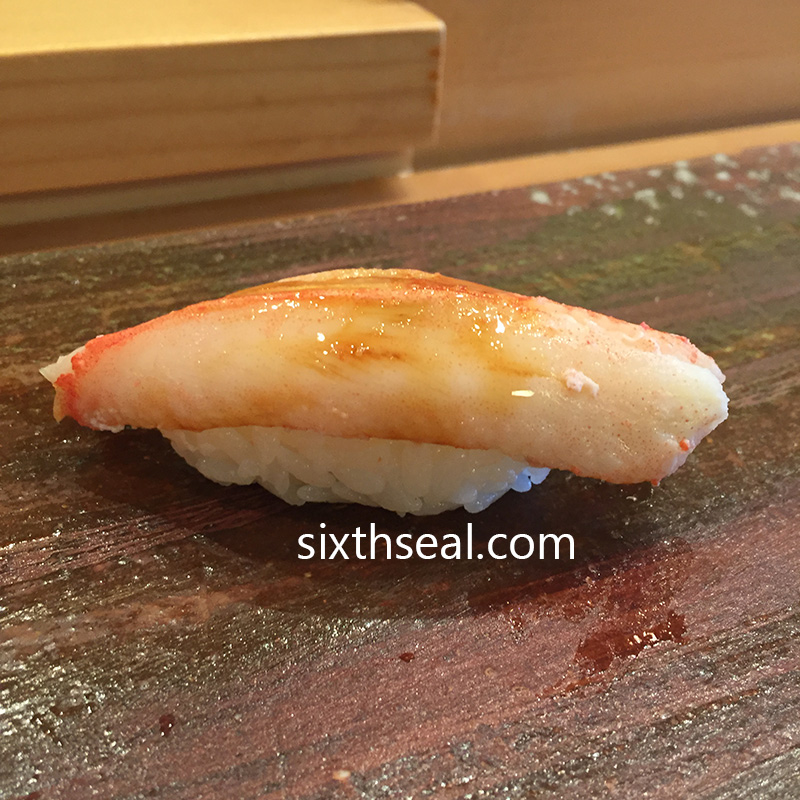
Zuwaigani (Snow crab/ズワイガニ)
Snow crab is one of the trio of crabs that’s abundant in Hokkaido around this time. It’s very sweet and pleasant tasting. This is one of the rare cooked sushi (the other is the Mantis Shrimp) and I’ve eaten it both raw and cooked in Sapporo and I prefer raw snow crab meat. However, cooked works better with the omakaze tempo.
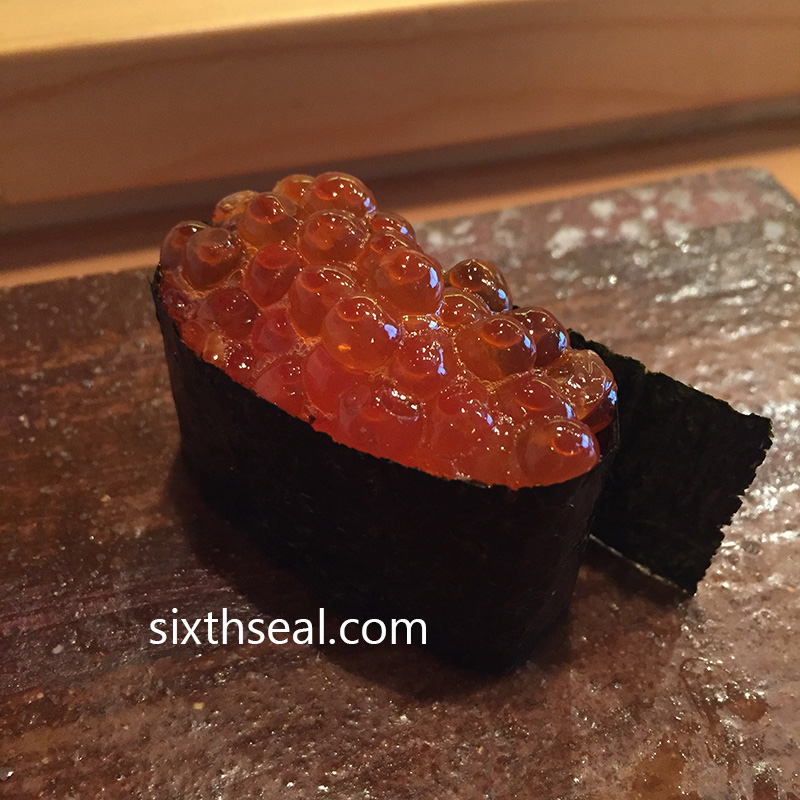
Ikura (Salmon roe/イクラ)
This is the first of the Gunkanmaki (Battleship Roll) – so called coz of the strip of nori (dried seaweed) that goes around the perimeter to hold in the topping. The salmon roe burst in my tongue, and the ratio was perfect (and generous).
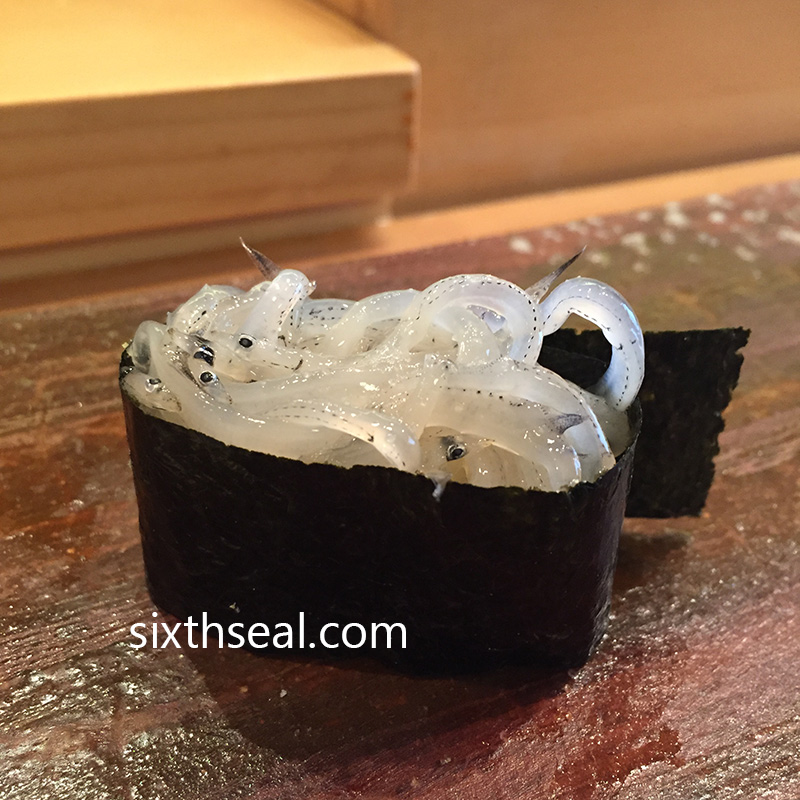
Shirauo (Japanese icefish/白魚)
I have heard a lot about these tiny transparent fishes and I saw them on the sushi counter when I came in. I vowed I’ll order them a la carte if I didn’t get it in my omakaze. Luckily, I did get one as part of my meal. It was another exclusive for the most expensive Jun set. I loved the way the little fishes rolled around my tongue. It’s ticklish.
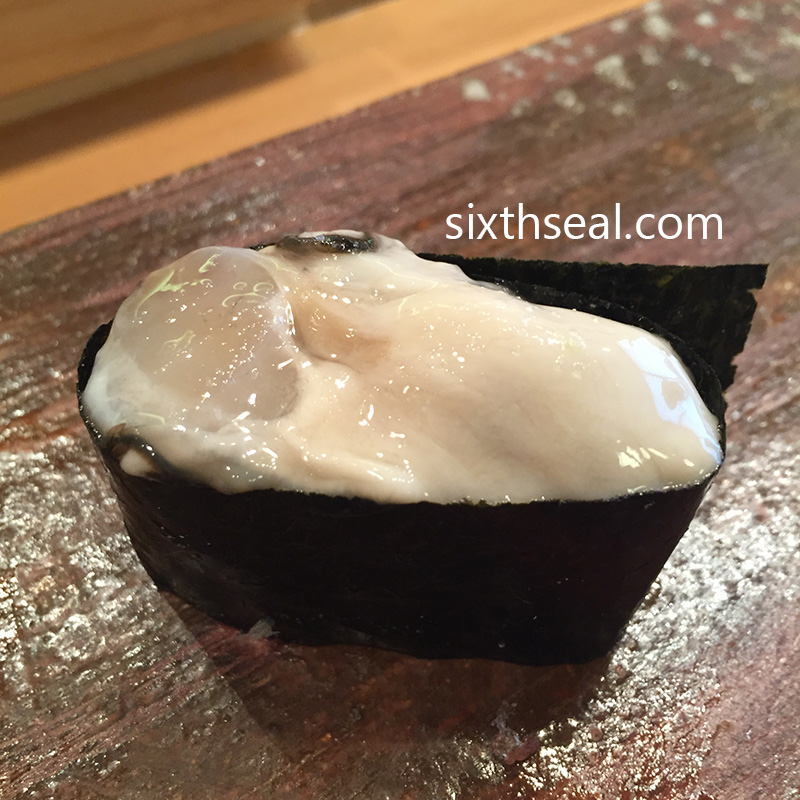
Namagaki (Raw oyster/生ガキ)
Yum! The saline and moreish raw oysters (there are two on the sushi) blew me away. It’s ultra fresh and local.
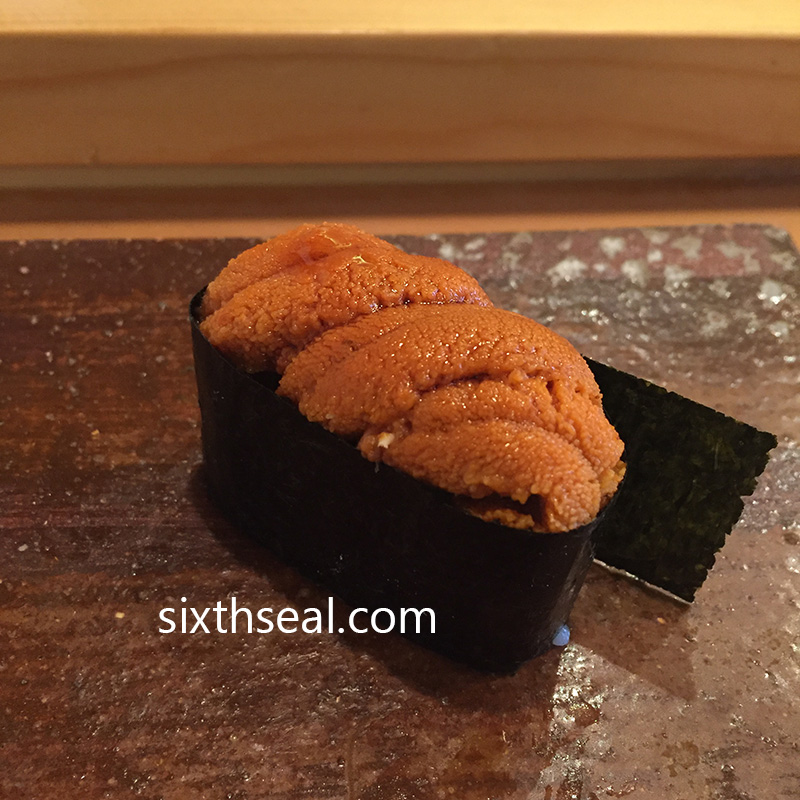
Uni (Sea urchin/うに)
What is heaven? I think this may be right beside it in the dictionary. Behold! The sea urchin in Otaru is Grade AAA compared to the sad specimens we get locally. This is a premium variety called ezo bafun uni (short-spined sea urchin) that’s caught in Hokkaido and best during spring. It was so creamy and delicious I nearly came in my pants. I know that’s not what a proper gourmand should be writing in a review but it’s true, so there! ![]()
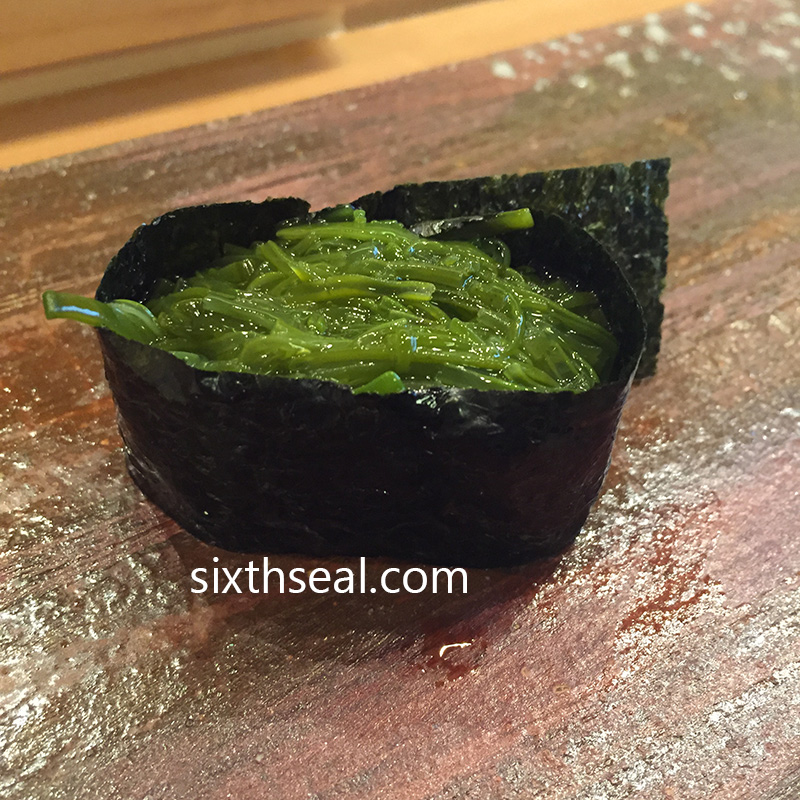
Wakame (Sea mustard/若布)
This is my last piece of sushi. It’s a palate cleansing topping of edible seaweed, what they call wakame or sea mustard. I’ve seen a similar item as the cheapest version of sushi at local conveyer belt places but this tastes nothing like it. It’s very slippery and fresh.
Isezushi Dai “Hokkaido Special” Omakase (12 pieces for JPY 3,600)

Hirame (Flounder/平目)
This is my dear’s omakaze which features only local Hokkaido seasonal ingredients. The first one was flounder or fluke.

Sake (Japanese salmon/鮭)
A beautiful slice of Japanese salmon. Too bad you’re supposed to eat sushi in one bite or I’ll have loved to try it.
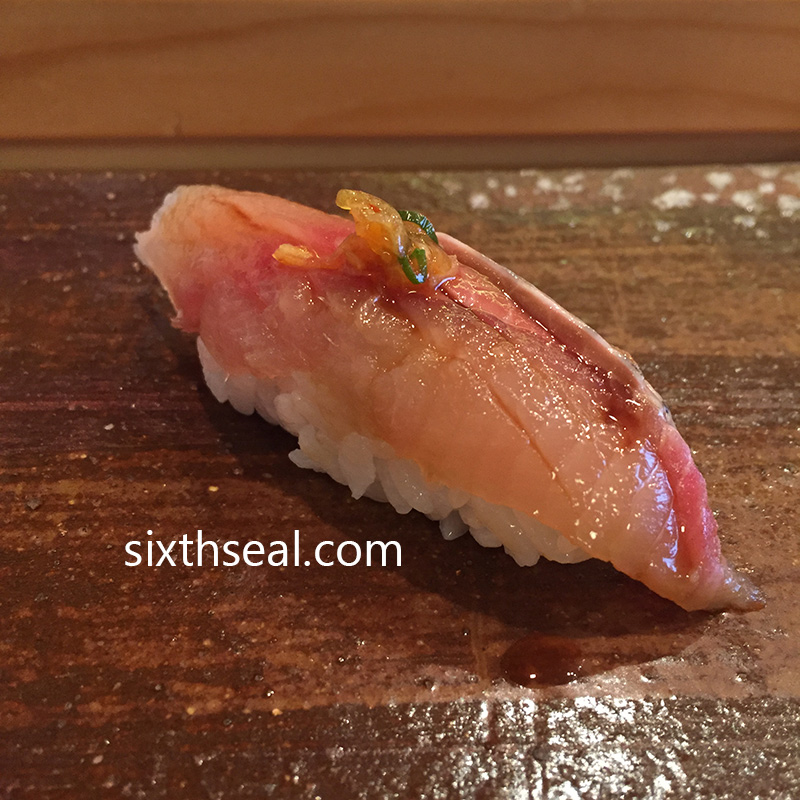
Kibinago (Japanese herring/黍魚子)
These are not the herring we’re using to seeing. The silver-stripe round herring is a Japanese species that’s very popular as sushi and sashimi in Hokkaido.
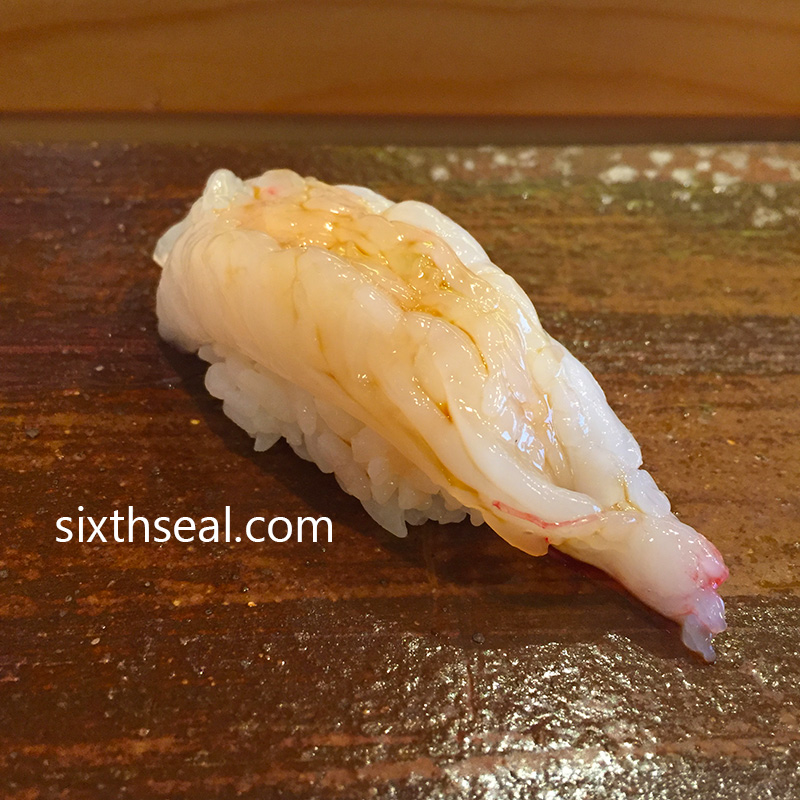
Botan-ebi (Sweet jumbo Japanese shrimp/ぼたんえび)
This is the same thing that I had, a local in-season sweet raw Japanese shrimp.
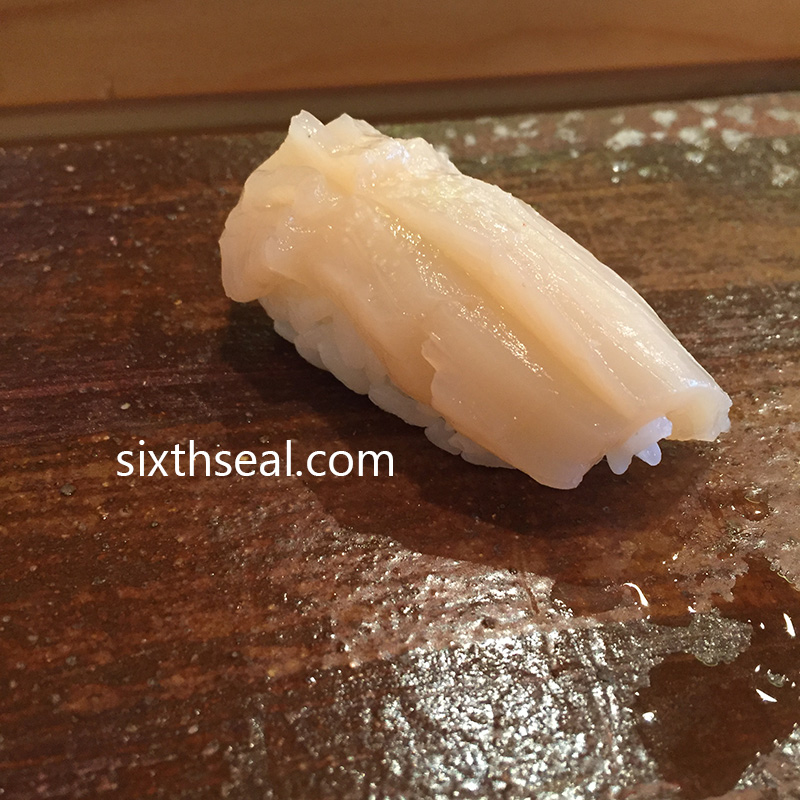
Hotate (Scallops/帆立貝)
I also had the local Hokkaido scallops. I was surprised to see that my dear liked it too!
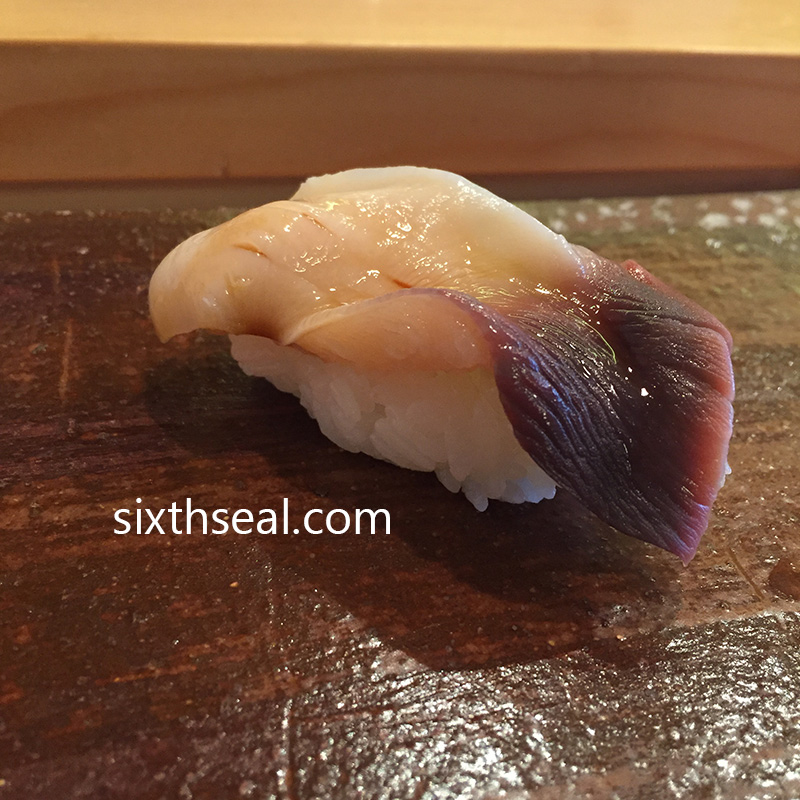
Hokkigai (Surf clam/ホッキ貝)
This was also on my Jun omakase. It’s a different picture though, due to the slight variations in the way it’s cut by the sushi chef.
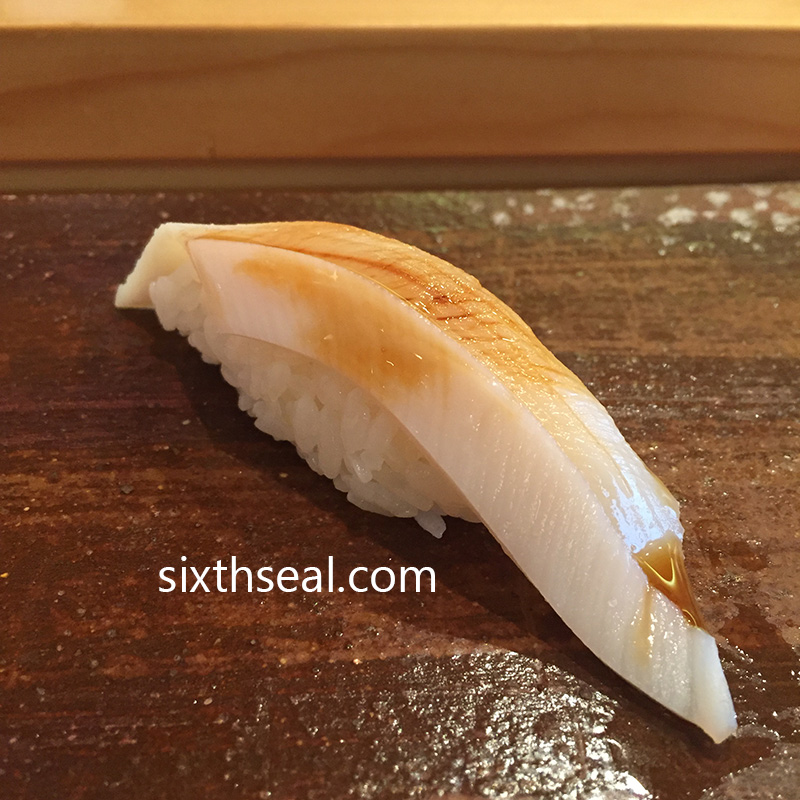
Mizudako (Octopus/たこ)
This was actually described as “Head of Octopus” to us. I guess that means this meat is from the head of the octopus instead of the tentacles of the cephalopod.
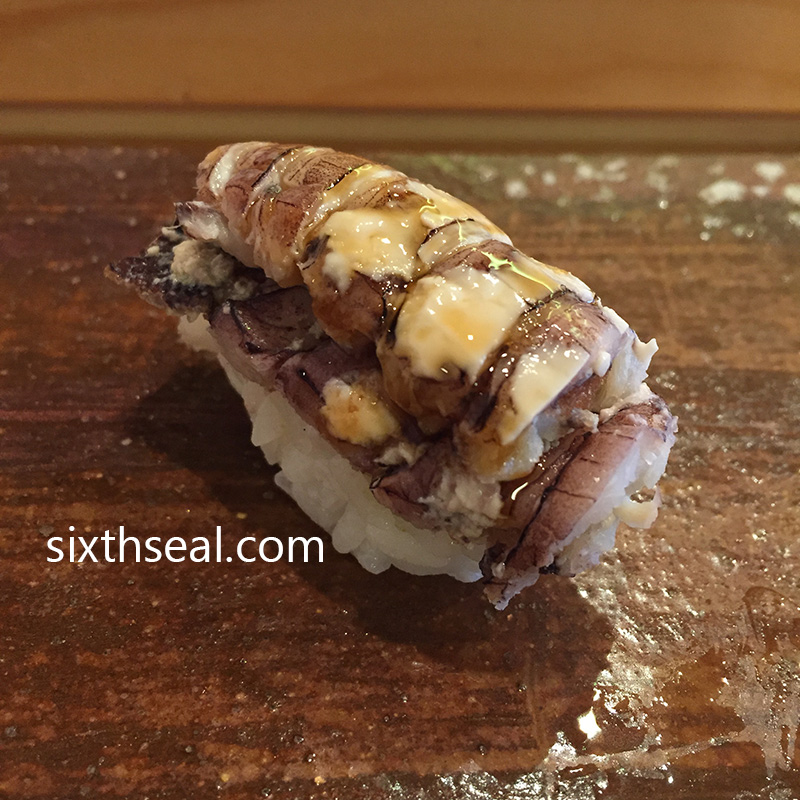
Shako (Squilla mantis shrimp/蝦蛄)
Yup, there are a few items that popped up on both our menus coz it’s a local Hokkaido specialty. My dear didn’t like the texture that much though. I personally thought the creamy sauce they made with the head of the mantis shrimp to top this sushi is out-of-this-world!
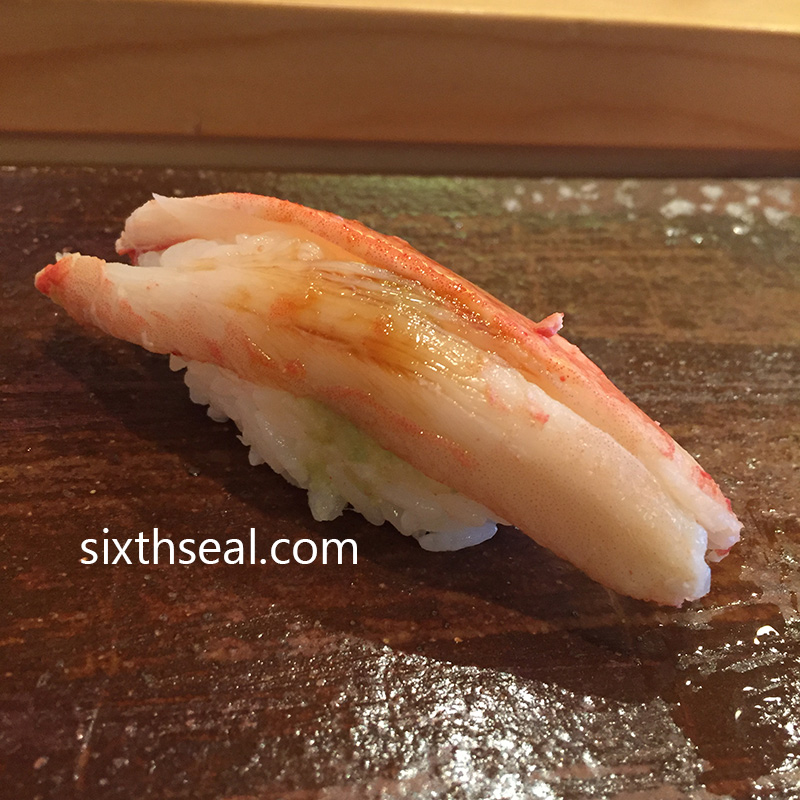
Zuwaigani (Snow crab/ズワイガニ)
Snow crab leg. I also had this and it was delectable.
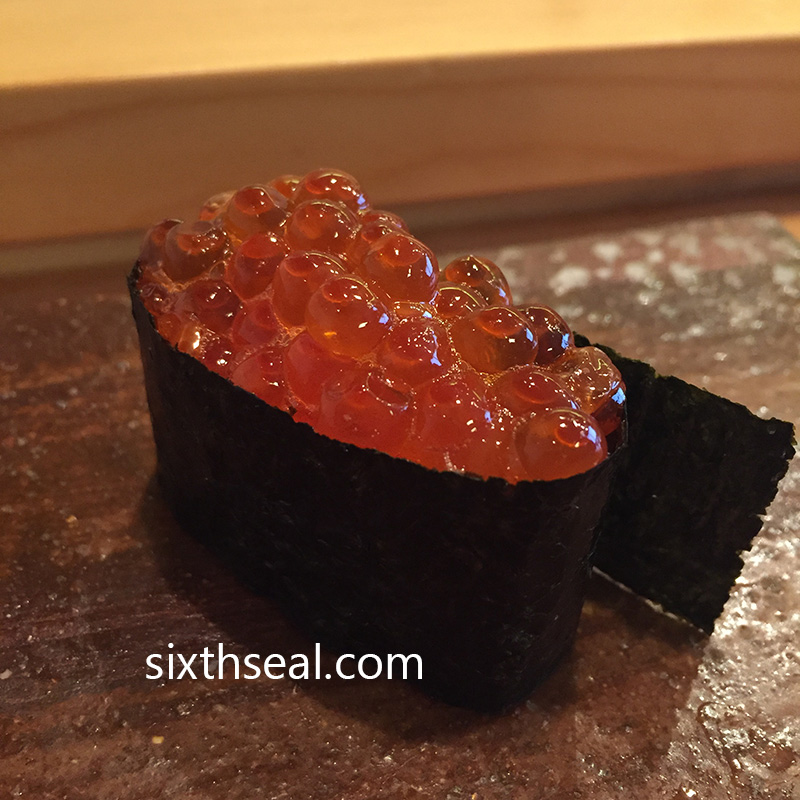
Ikura (Salmon roe/イクラ)
These are roe from local salmon, very rare.
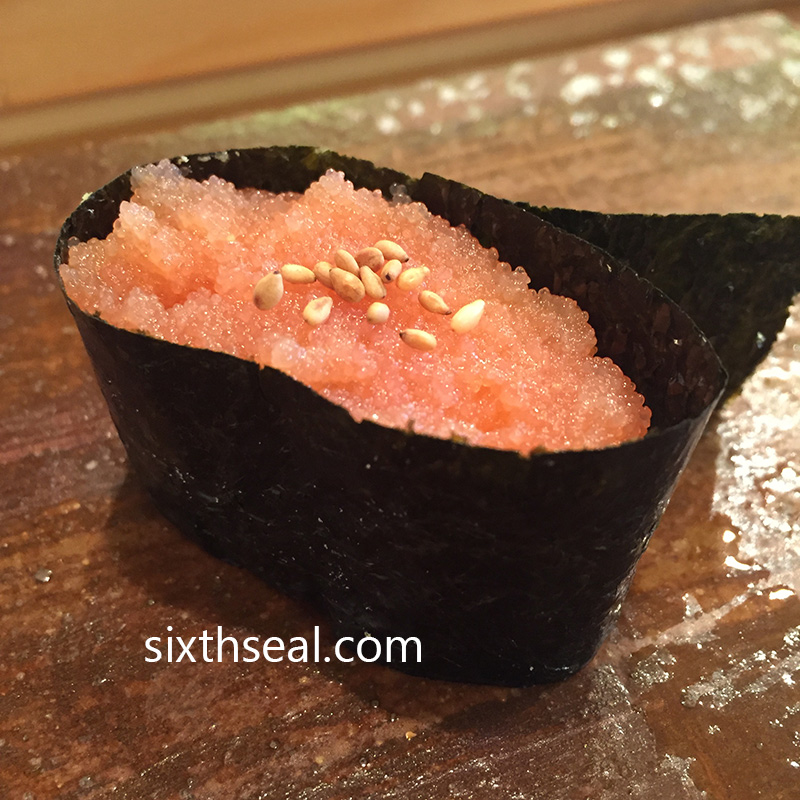
Komaiko (Saffron cod roe/コマイ)
I’m not sure if I got the hiragana correct or not but the romanji is right. Komaiko means saffron cod roe and it’s quite an unusual topping for sushi. The sushi chef sprinkled a few toasted sesame seeds on top. I wish I could have eaten this too but I know etiquette says you’re not supposed to share so we didn’t. I did order a la carte after though. Haha.
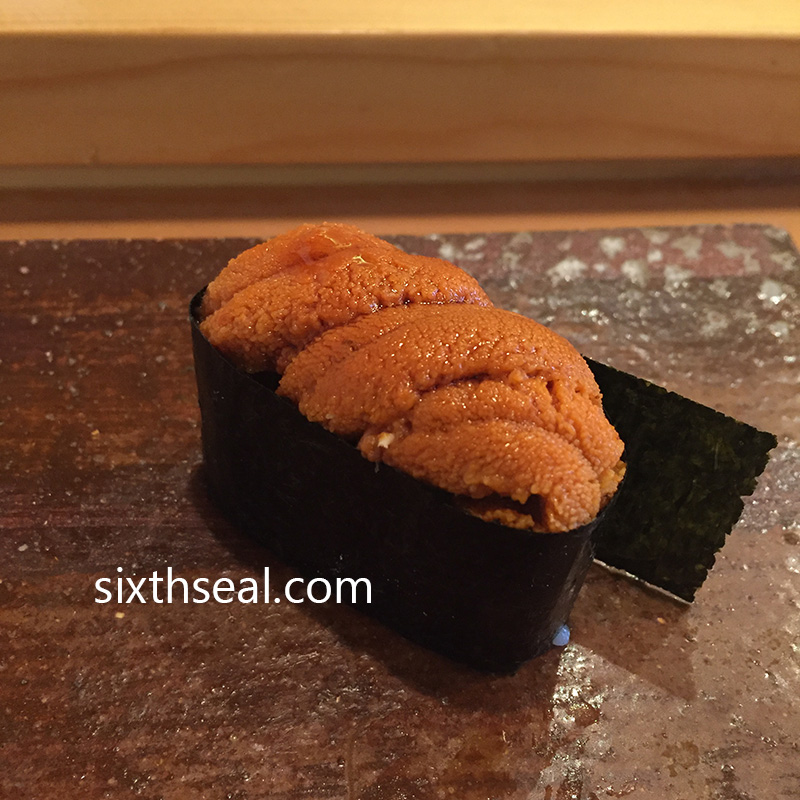
Uni (Sea urchin/雲丹)
Her Dai omakaze ended with luxurious uni as well. The sea urchin gonads are exquisite! Hokkaido uni is said to be the best in the world and this is ezo bafun uni, the best of the best. It’s nicknamed sea chestnut coz it tastes like chestnuts and comes in beautiful orange. My better half loved the sushi here (while she’s usually apathetic about local sushi) coz the rice is actually warm/hot instead of cold! The rice-to-neta ratio is very generous too and it’s just better in every single way.
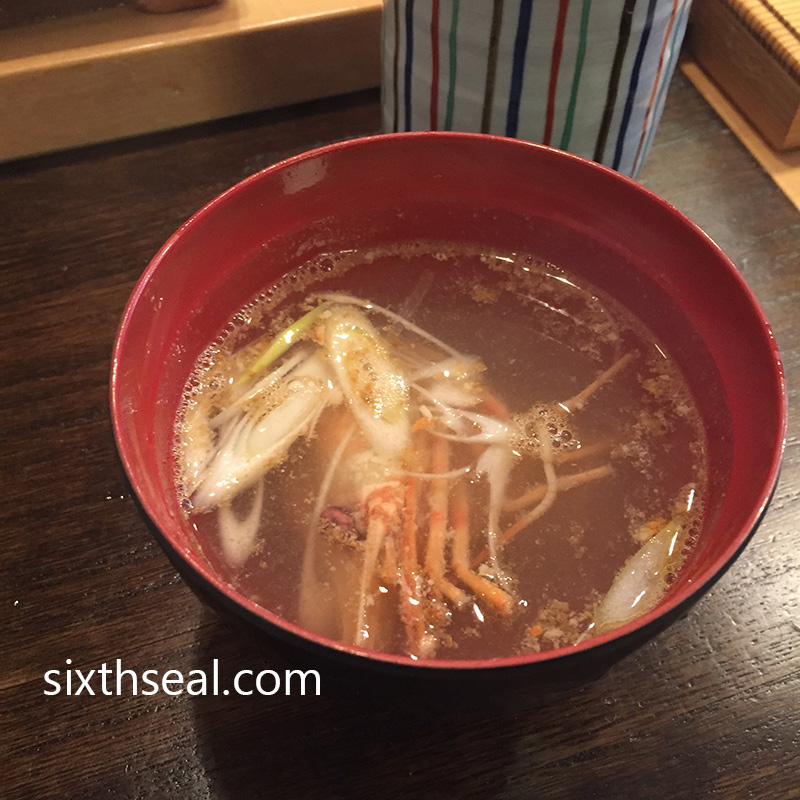
We were given a miso soup fortified with botan ebi (sweet Japanese jumbo shrimp) at the end of our meal.

I actually ordered two pieces of sushi a la carte after this. The first was to make up for a mistake. I was so enthusiastic about eating that when my tsubugai (whelk) sushi was served up, I actually *ate* it before my better half could take a photo. -_- Thus, I ordered it again so my dear could snap a quick picture. That’s how I have a photo even though I ate it before she could take it. We ordered it TWICE. She had it this time but didn’t like it coz it was too crunchy.
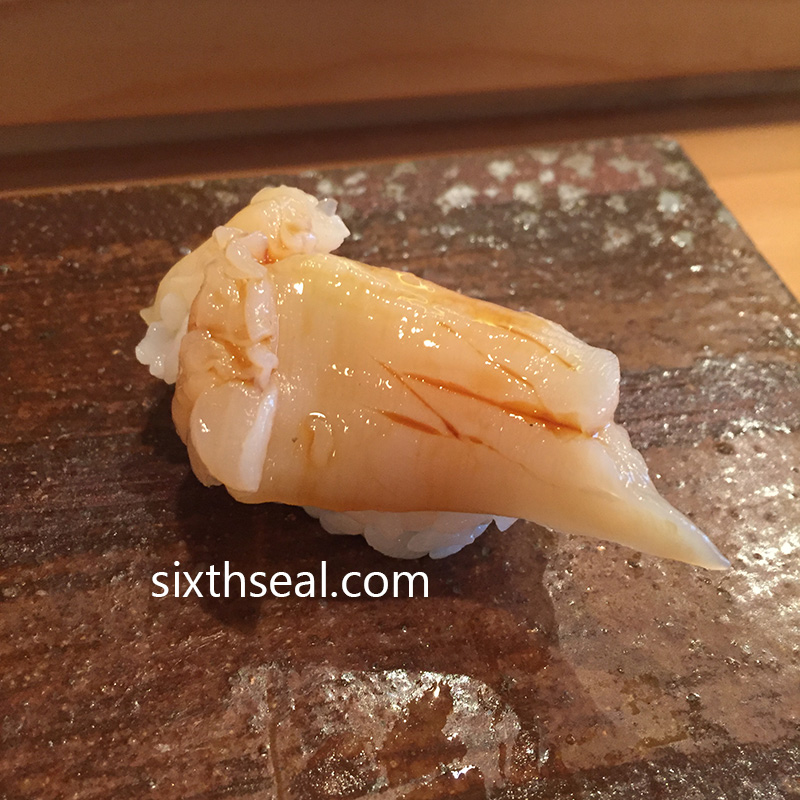
Shiro mirugai (Geoduck giant clam/海松貝) JPY 880
I wanted more, especially since I had perused the extensive a la carte sushi menu and found geoduck. I asked for shiro mirugai and was surprised (and a little embarrassed) to hear the collective gasps from the other diners beside us. The two Japanese women muttered amazed exclamations when the sushi chef presented the geoduck sushi to me. The lone Japanese male taking up the last counter seat grunted his approval too. It was very nice. I’ve never had geoduck raw before and it’s so fresh in Japan.
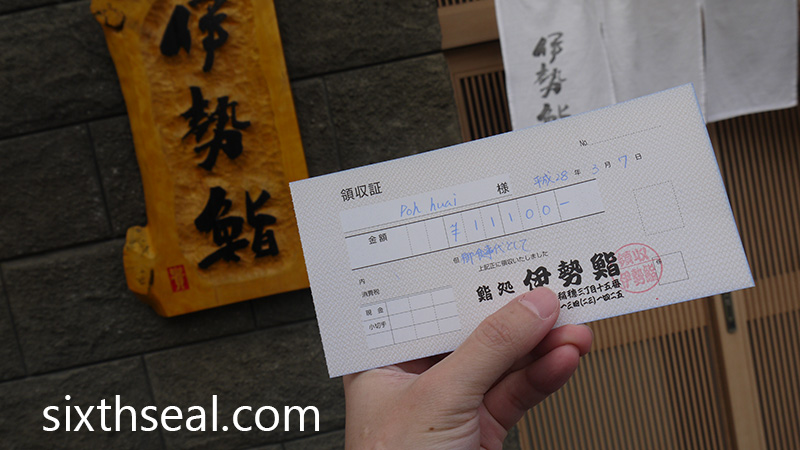
I later realized that the geoduck was the most expensive item in the a la carte menu, which explains the Japanese women’s reaction. My omakaze was nearly double the price of my dear’s despite only having 4 pieces more but the four pieces were premium items like otoro and icefish. The bill for the both of us came up to JPY 11,110 (RM 473 according to my exchange rates) which is very reasonable.
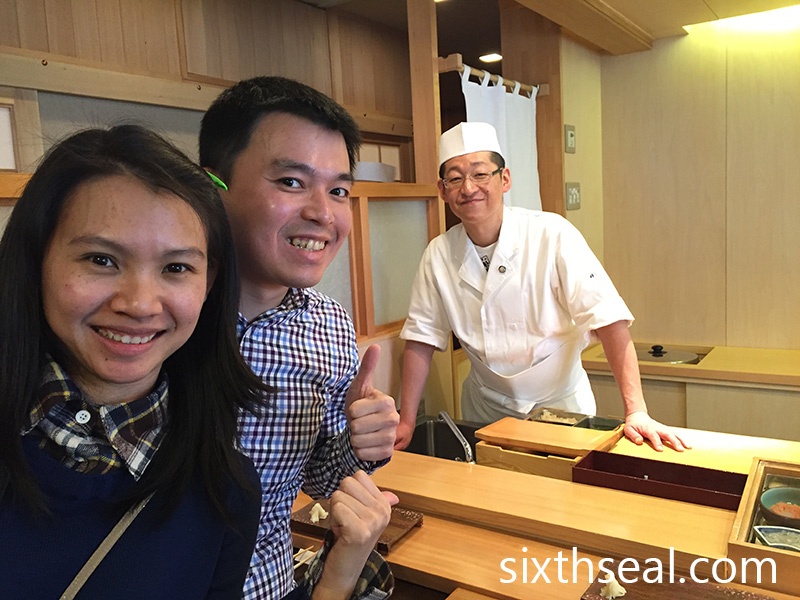
Isezushi (伊勢鮨) in Otaru, Hokkaido is a must-visit if you ever go there on a day trip. Be sure to make reservations and ask for a counter seat. The omakaze items changes depending on season so your neta (sushi topping) may vary. Oh, and the two nice Japanese aunties took a photo of us with the sushi chef. 🙂 We were really glad we had an authentic sushi experience at a 1 Michelin Star restaurant. It was truly a delightful afternoon in Isezushi.
wow, you go try edi, this is so expensive oh…
It was relatively cheap for a 1 Michelin star sushiya. 🙂
It’s highly rated on Tabelog too, so we had to check it out. The best part was that all the customers inside were Japanese. You can’t do walk-ins and you must have a reservation, so no out-of-country people (except us, obviously).
I really regret reading your blog so late at night. This is making me so hungry again! I’ve never seen those small ice fish before. Do they have bones inside? The sea urchin totally different colour from Malaysia one. Yours look so yum. I would like the snow crab also. I never eaten in a Michelin star restaurant before. Do they allow you to take photos? Your sushi photos are so big and delicious I want to eat my monitor. ^^
Nope, there are no bones in the Japanese icefish. 🙂
They’re sometimes eaten alive too, swimming in water. You just grab some and eat them with rice. They’re quite tasty, very very small fish, never had something like that before. No problems with taking photos in Michelin star restaurants, we had a great time in a French 2 Michelin Star restaurant in Paris too:
http://sixthseal.com/2014/04/our-2-michelin-star-lunch-at-le-relais-louis-xiii/
All the sushi look so fresh and delicious, especially the uni sushi that I am drooling now. Uni sushi costs RM45 for two pieces. Your geoduck sushi is about RM38? If so, it is more expensive than Uni sushi here. I have eaten raw geoduck before in Unique Seafood I think.
Does this sushi bar serve shirako sushi? I wouldn’t dare to try shirako sushi.
Yeah, the uni in Hokkaido is superb! 🙂
They only use ezo bafun uni, which is a species of uni called “sea chestnut” for the orange color. It’s best eaten in winter and it’s really delicious and different from regular lower grade yellow uni. This is the best of the best uni. No shirako though, probably not in season, they only serve things which are in season and fresh.
The chef looks rather academic, like a college professor. LOL!!! My girl loves sushi – I’m just ok with the ones here – you’ve tasted one, you’ve tasted them all. These. for sure, are nothing like those run-of-the-mill ones.
Yeah, my better half loved the sushi here! 🙂
At first she wasn’t keen at all, wanted ME to eat her omakase menu, but after she had a piece she changed her mind. This sushi is totally different from Malaysian crappy sushi. Their rice is hot and their fish is fresh. I wasn’t a fan of sushi when I was young too, also thought it was all the same. Only when I started eating it more and eating different ones did I know what was good and what was bad. I didn’t have a baseline to compare previously too.
LOL! That was a costly but funny mistake for you. Lots of unique sushi that I never seen in KL. Real snow crab especially hard to find. Hope I am able to try them one day.
Yeah, I was too happy with the sushi that I ate it before she could snap a photo. 🙂
I had to order it again after the omakase was done. Snow crab is always better eaten in the source country, I’ve had snow crab and king crab locally and it can’t compare to Japan or Korea. The uni you must try if you’re in Japan, it’s a species which you can’t get here.
This is expensive, but how many times you get chance with Yee Ling to come over Isezushi to try it again? Perhaps this is best moment and experience you both enjoyed during this trip.
Erm, I like Japanese Ryouri and so do my son and my hubby. All those sushi is so fresh and worth to be eaten, hahaha. Other places I can’t say much, but Japan’s food is worth it.
It’s actually not too bad! 🙂
I’ve eaten more expensive Japanese food in Malaysia and it’s nowhere near as nice as this one. Yeah, the sushi in Japan is amazing eh? My better half doesn’t even like sushi, she actually wanted me to eat her omakase but changed her mind after the first piece came out. Haha. Japan is awesome, 10/10 would go back again.
OMG how could i miss this! I love Otaru, I visited in the summer a couple years back, I think I need to revisit the place soon 🙁
Otaru is a nice place! 🙂
It’s quite commercialized now though, this was a very out-of-the-way place we found and you can’t do walk-ins, gotta have a booking so it can be hard for tourists to go. It’s all Japanese people inside, and that’s what makes it awesome.
spectacular! i’m not sure i would have persevered through those two long-distance calls since they don’t take online reservations, but your experience is proof that perseverance and determination really are worth it! 😀 the otoro looks really glorious, the shako looks stunning, the ice fish and oyster look really tempting too … anyone who stumbles on this post while researching this restaurant would definitely end up making a reservation! 😀
Yeah, a lot of good restaurants in Japan don’t take online reservations. 🙂
I strongly suspect it’s partly to filter out the tourists and the non-committed since the people who call are highly likely to also turn up. Otherwise, they’ll have to do it like Michelin star places in Paris and ask for a non-refundable 200 Euro deposit (which we paid for our 2 Michelin star meal in France). The seafood is awesome in Japan, the uni in particular was amazing.
I thought I would have just let you dine inside while I go for shopping..Hahah I thought I have to eat all the sushi within the certain amount of time allocated as what you told me in Jiro’s sushi restaurant. Glad it wasn’t that kind of experience but rather fine and relaxing while indulging the sushi. 12 pieces isn’t full at all…Maybe another 12 more.
Yup, this one is more relaxed and only locals inside! 🙂
It’s not like the 30-minute only dining of Sukiyabashi Jiro. I was surprised too that 18 pieces of sushi wasn’t full for me too, I could have easily eaten another 18. Maybe partly it was coz it was nice and partly coz we walked so much in Hokkaido that we needed to eat more to fuel up.
What a dining experience!
It’s a memorable one indeed! 🙂
What a beautiful feast! I love uni, i had it once in Tsukiji Market and I could never find anything close at home. I can’t imagine how the best of the best Japanese uni taste like!! Also amazed at how affordable the omakases are considering how premium the sushis offered! Thanks for sharing this gem HB
Yeah, the uni in Japan is totally different! 🙂
They use a local uni called ezo bafun uni (short-spined sea urchin) that we can’t get here. I love how orange it looks, it’s beautiful and it tastes awesome too. Indeed, the price was quite a surprise, would have expected it to be 2 times more and honestly I would have happily paid twice the price for this experience. Thanks for reading Kim!
that’s a one-in-a-lifetime experience to dine in a one-Michelin star sushi place. I never go to a ‘reserved’ only sushi restaurant, whatmore with one-star. Yea, the sushi looks premium, fresh and definitely reasonable with the quality of seafood/fish being served.
Yeah, this is the first Michelin star sushiya I’ve been to! 🙂
We have been to Michelin star places in France though, but this was completely different. The customers are all Japanese, you can’t walk in coz you need a reservation. In France they allow online bookings coz you have to pay a non-refundable 200 Euro (at least) for a booking but that doesn’t happen in Japan so they just don’t allow online bookings.
The sushis really looks so good and fresh! I am a sushi lover and in a michelin star sushi restaurant, these delicacies must be heavenly!! woah!
Yeah, it’s honestly the best sushi I’ve ever eaten! 🙂
what a feast! and I agree one should always sit at the bar, no matter how cramped 🙂 Next time, i am in Japan I will look out for this place!
The bar is the ONLY place to sit! 🙂
We would have gotten our sushi on a long plate if we had sat on the tables. Luckily I called twice to make sure it was a counter seat, it was fully booked when we arrived (2 other Japanese females and a Japanese male + us for the 5 seat counter).
I’ve to admit it’s pretty good deal for such fresh seafood. Awesome photography, love every bit of it!
Thanks Shirley! 🙂
Yes the Japanese are very punctual and being early shows our earnest respect which would please them a lot. The chef looked happy.
I must say that your sushi photos are so delicious and alive as your photography was so sharp & superb! Hey, I studied photography in the States, so I mean it. Even the tiny Saffron Cod Roe looked so alive and yummy. Well done!
Yup, they are very particular about time. 🙂
It’s a good thing. If you respect the time, they’ll respect you too. The reservations are for a 30 minute window only so it was a good thing we arrived early.
Sushis! They look so so beautiful, very fresh too.. My favourite gotta be that Uni.. Looks so creamy and melts-in-the-mouth type.. Yummz, I can imagine myself swallowing the whole thing..
The uni is awesome! 🙂
This is ezo bafun uni, only found in Japan and best in winter.
Hi again from Sibu. Sadly, all these food are so good to look at. If I gain weight, I will lost my certificate of recognition for losing weight. May be in my dream at night, I will be eating all these without gaining weight when I wake up. I hope you are healthy and living your full potential in life.
Thanks mate! 🙂
It was one of the best meals I’ve ever had. Definitely the best sushi I’ve eaten.
What a great experience! They’re all ok with the photo taking?
I heard Japanese are quite particular about it.
Yup, they’re okay with the photos. 🙂
Generally with food, it’s okay, we took photos in Paris during our 2 Michelin star meal too. Of the chef, I asked first, a good phrase to learn is “is it okay” (ee yo ka – something like that) and he happily took a photo with us. Taking photos of people in private spaces you have to ask first, but otherwise food is fine.
Wow, appreciate the effort u explain one by one the taste of the sushi to your readers, like we are eating lively with you 😛
Thanks Choi Yen! 🙂
It was the best sushi I’ve ever eaten and I was really looking forward to eating here. I bugged my dear to arrive early too so we could double check the time. Haha.
your post totally makes me hungry! These sushi look so fresh and yummy! Have a great time in Japan!
Thanks Gail! 🙂
These are sushi I can only dream of….:'(
You can always go to Japan! 🙂
I’m definitely going back, it’s such an awesome place.
that’s a lot of close up shot on each sushi, beautiful! it also shows the skills of their chef in japan. and definitely fresh!
Cheer mate! 🙂
That is a whole lot of rice in there. I always prefer to eat sashimi to sushi as I don’t eat much rice. I’ve eaten Uni here once and absolutely love it. I can imagine how much better yours are.
I shy to eat in front of counter. Haha. Scared the chef will judge me for taking pictures and all 😀
It’s not a lot of rice at all! 🙂
The Japanese only put a little rice to go with the sushi, unlike our sushi. It’s the proper way, the rice to neta ratio is super low. I love uni too, and this is the first time I’ve eaten ezo bafun uni since it’s only available in Japan. It’s best eaten in winter too, perfect timing. It’s okay to take photos, the counter is the only place to eat sushi since the chef can place each one on the wooden board one-by-one.
These unique sushi don’t look like what I usually have, I must say you guys are really adventurous, I usually eat Hana Maki, Ebi mentai sushi (Prawn sushi with codfish roe), California Maki and Crabstick sushi
This was the omakase menu! 🙂
We didn’t choose, the chef chose for us. I love eating different types of sushi and the omakase menu I went for was the most premium one while my dear went for the mid level one which features Hokkaido specialities. It was great. The uni here is superb, it’s a local species called ezo bafun uni that’s sunset orange and tastes totally unlike any other uni I’ve ever had.
Thanks for writing this! I’m planning to visit Sapporo in November and will be taking a day trip to Otaru! Do you think about 4 hours is enough to eat + do some sight seeing over there?
Also, are there any other must eats in Otaru you’d be willing to recommend? c:
Hi, we’re actually heading to Otaru near Christmas and would love to try this place, can you share your experience calling the restaurant for your dinning requirements? Did you speak English or Japanese? Do you know if they allow children (8 years old) ? Appreciate your advice!
I have a 1 year old, prob can’t go eh?
Thanks for this amazing recommendation. How long did the full meal take?